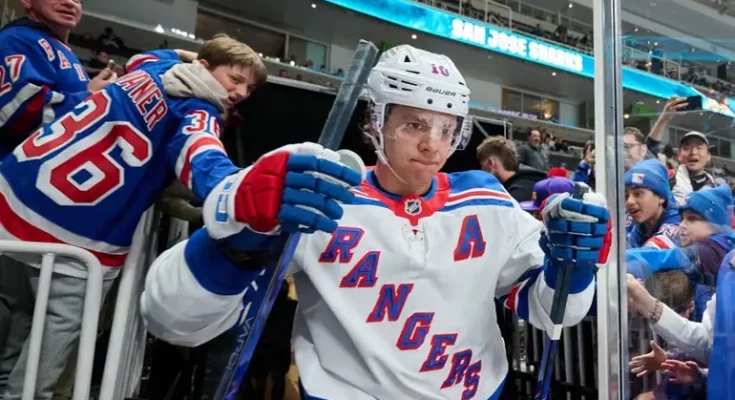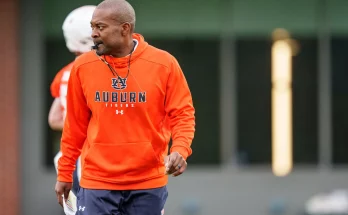With Just One Year Left on Panarin’s $81.5M Deal, Rangers Face Major Crossroads
The New York Rangers are at a critical juncture with just one year remaining on Artemi Panarin’s seven-year, $81.5 million contract. The blockbuster deal, which brought Panarin to Broadway and the Madison Square Garden spotlight, has shaped the team’s identity and offensive firepower over the past several seasons. Now, as the final year of the contract looms, the franchise finds itself grappling with significant decisions about its future direction, financial flexibility, and long-term competitiveness.
Panarin arrived in New York amid much fanfare, hailed as one of the NHL’s most dynamic offensive players. Known as “The Bread Man,” his ability to create scoring opportunities, control the puck, and deliver clutch performances quickly made him a cornerstone for the Rangers. His presence on the ice lifted the team’s status in a crowded Metropolitan Division and positioned New York as a legitimate contender year after year.
But now, with the contract entering its final stretch, the organization must face tough questions. Does the team move forward with Panarin and try to negotiate an extension? Or does management consider other options, such as trading him for future assets before his contract expires and he potentially walks away in free agency? The stakes are high, and the outcome will significantly influence the Rangers’ roster and salary cap situation.
Financially, Panarin’s contract is a major commitment. The $81.5 million deal spread over seven years has paid dividends in performance, but it also limits the Rangers’ flexibility in managing other roster needs. With the NHL’s salary cap environment constantly shifting, balancing the books while maintaining a competitive lineup is a challenge. The decision to extend, trade, or let Panarin walk could create a ripple effect that shapes how the Rangers assemble their team moving forward.
From a hockey standpoint, Panarin remains an elite offensive weapon. His skill set is rare—blending speed, creativity, and an uncanny ability to read the game. He consistently ranks among league leaders in points and assists, and his impact goes beyond just scoring. Panarin’s presence on the ice demands attention from opposing defenses, often opening up space for his linemates. Losing a player of his caliber would be a substantial blow to New York’s attack.
However, the team’s leadership must weigh these on-ice contributions against the realities of contract negotiations and long-term planning. If Panarin seeks a lucrative extension in line with his star status, the Rangers must consider whether that fits within their broader roster construction and salary cap strategy. Alternatively, if the team decides to shop Panarin, they will need to identify trade partners willing to meet the asking price for a player entering the last year of his deal.
The timing of these decisions is delicate. With only a single year remaining, the Rangers risk losing Panarin for nothing if they wait too long and he chooses free agency. This scenario would leave the team scrambling to fill the offensive void and adjust their salary cap commitments with limited assets in return. Conversely, making a move too early could disrupt team chemistry or lead to less-than-ideal returns in a trade.
Another layer to consider is Panarin’s own perspective and desires. Players of his caliber often have preferences about where they want to play and the competitiveness of the team. If Panarin sees a future with the Rangers and the organization presents a compelling vision, there is potential for a contract extension that keeps him in New York beyond this upcoming season. This outcome would provide stability and continuity for both parties.
On the other hand, if Panarin seeks a new challenge or a more favorable financial arrangement elsewhere, the Rangers must prepare for a potential parting. In that case, maximizing his trade value becomes paramount. Teams in need of scoring talent will be circling, especially contenders looking to make a splash before the trade deadline or upcoming free agency periods.
Beyond the individual player and contract considerations, this crossroads also highlights the broader dynamics of the Rangers’ roster construction. The team has built a promising core of young players in recent years, blending veterans and rising stars. How Panarin fits into this mix moving forward will influence everything from line combinations to power play strategies and leadership roles within the locker room.
From the fans’ perspective, Panarin has been a fan favorite since day one. His electrifying style of play and engaging personality have made him a face of the franchise. Any talk of moving on from him generates strong emotions and debate among the Rangers faithful. They understand the business side of hockey, but the attachment to a player of Panarin’s caliber runs deep.
In terms of team competitiveness, the Rangers are striving to break through and make a sustained run at the Stanley Cup. Panarin’s contributions have been central to that goal. Whether the team can continue to compete at a high level with or without him will depend on how well they navigate this pivotal contract situation.
Looking ahead, the Rangers’ management and front office staff will be under intense scrutiny. Their ability to craft a plan that balances financial responsibility with on-ice success will define the next chapter for the franchise. Whether that involves re-signing Panarin, orchestrating a trade, or shifting their roster priorities, it will be one of the most critical decisions in recent team history.
The NHL landscape is constantly evolving, and teams must adapt quickly to remain relevant. For the Rangers, the decision surrounding Panarin’s contract is more than just a financial calculation—it’s about shaping the identity and trajectory of one of the league’s most storied franchises. The pressure to get it right has never been higher.
As the countdown begins on the final year of Panarin’s deal, all eyes will be on New York. Fans, analysts, and league insiders alike will be watching closely to see how this crossroads is navigated. The Rangers’ choices will have lasting consequences, setting the tone for seasons to come.
In summary, the New York Rangers stand at a defining moment with just one year left on Artemi Panarin’s $81.5 million contract. The team must carefully weigh its options—extension, trade, or risk losing him to free agency—while balancing competitive aspirations, salary cap realities, and fan expectations. How this situation unfolds will shape the future of the Rangers’ roster and their quest for hockey glory. The coming months promise to be filled with drama, high-stakes negotiations, and decisions that will echo throughout Madison Square Garden and beyond.



